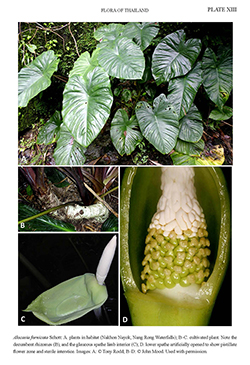e-Flora of Thailand
Volume 11 > Part 2 > Year 2012 > Page 122 > Araceae > Alocasia
3. Alocasia fornicata (Roxb.) Schott
Oesterr. Bot. Wochenbl. 4: 410. 1854; Schott, Syn. Aroid.: 47. 1856; Schott, Prodr. Syst. Aroid.: 151–152. 1860; Engl. in A.DC. & C.DC., Monogr. Phan. 2: 505–506. 1879; Hook.f., Fl. Brit. India 6: 526–527. 1893; Krause in Engl., Pflanzenr. IV, 23E (Heft 71): 94–95. 1920.— Arum fornicatum Roxb., Fl. Ind. ed. 1832, 3: 501. 1832.— Colocasia fornicata (Roxb.) Kunth, Enum. Pl. 3: 41. 1841. Plate XIII.
Accepted Name : This is currently accepted.
Description : Medium-sized, clumping, evergreen herb to 1.5 m with watery latex. Stem erect to later decumbent, the zone just behind the active portion with sparse fibrous cataphyllary remains. Leaves several together, clustered at the tips of stems of larger plants; petiole to 1.5 m long, dull purple; petiolar sheath somewhat membranous; leaf blade peltate, cordate-sagittate or cordate ovate, to 100 by 80 cm, apex short acuminate, base margins undulate; primary lateral veins 9–12 on each side; interprimary veins forming well-defined interprimary collecting veins, the blade adaxially somewhat quilted between the primary vein and interprimary veins. Inflorescences 2 together, subtended by membranous cataphylls at anthesis; peduncle stout, ca 45 cm long, much exceeding the cataphylls at anthesis, medium dull purple; spathe 10–12 cm long, constricted about ⅙ of the way from the base; lower part ovoid, grey-green slightly glaucous; spathe limb broadly oblong-lanceolate, 10–30 by 4–8 cm, hooded at anthesis, later reflexed, then deliquescent, membranous, exterior grey-green, interior greenish white; spadix shorter than the spathe, shortly stipitate; pistillate flower zone 1–2 by ca 1.5 cm; ovaries brownish green, ca 3 mm diam., ascending; stigma sessile, weakly 3-lobed, the lobes blunt, tan; sterile interstice narrowing abruptly above the pistillate zone, then equalling the staminate zone, ivory, very slightly narrowed corresponding to the spathe constriction; synandrodia composed of rhombo-hexagonal stamens, ca 2.5 mm diam., the lowermost ones enlarged and very irregular; staminate flower zone cylindrical, ca 3–5 by ca 1.5 cm diam., whitish; synandria rhombo-hexagonal, convex-topped owing to cap-forming synconnective, ca 1.5 mm diam.; appendix elongate-conical, 3–5.5 by 1–2 cm, equalling length of the spadix, only very slightly thicker than the staminate zone at the base, then gradually tapering, white. Fruiting spathe 6–8 cm long, green; fruits globose, ca 5 mm diam., ripening scarlet.
Thailand : SOUTH-EASTERN: Chanthaburi.
Distribution : NE India (Meghalaya: Khasia – type), N Myanmar.
Ecology : Primary and secondary humid evergreen to seasonal evergreen forests, riverbanks; below 1,000 m alt.
Vernacular : Kradat dong (กระดาษดง)(Central).
Notes: Alocasia fornicata is one of several large, superficially similar, Alocasia species that occur along the Himalayan corridor from NE India to SW China with southern extensions into the mountainous parts of Thailand as far south as the Cambodian border, N Laos & Vietnam; other names (type localities) include A. fallax Schott (India – Meghalaya: Khasia), and A. decipiens Schott (Myanmar – Pegu).
Doubtless because their size and irritant sap render them troublesome to collect, virtually all species are very poorly represented in herbaria, and often with fragmentary type material. Furthermore, being succulent, they are difficult to dry so even modern herbarium material is invariably of poor quality. Consequently these species not well understood taxonomically and the application of the epithet fornicata to this species in Thailand is somewhat tentative.
Alocasia fornicata as interpreted here is most similar to A. odora from which it differs by a proportionately stouter pistillate flower zone with ascending pistils and much more conspicuously 3-lobed stigmas, and a suprapistillar sterile zone that narrows abruptly and is closed in the lower part with highly irregular synandrodia.

